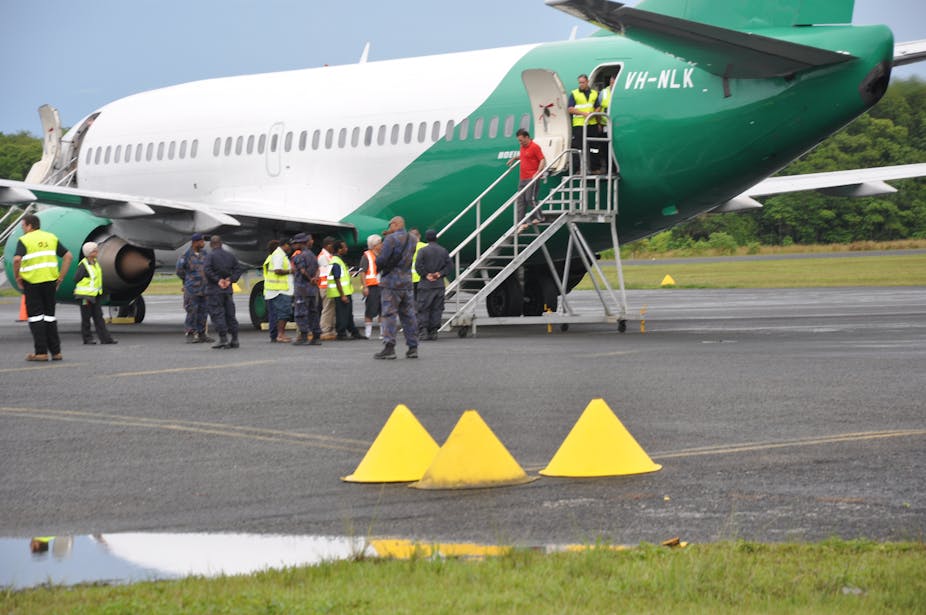Have you ever wondered why asylum seekers would choose to spend $5000 for passage on an overcrowded, dangerous, and potentially fruitless boat journey from Indonesia rather than spend it on a first class plane ticket to Australia?
Perhaps the answer seems obvious. Legally regulated travel into first world countries is reserved for those with valid passports and visas, which are out of reach for this group. But how and why this came to be the case merits closer examination.
In addition to the practical barriers that asylum seekers may already face in obtaining travel documents from their own governments, Australia’s intelligence-led visa policies stack the odds against individuals from countries designated as “high risk”. This often includes countries generating high numbers of asylum applicants.
In the past, the lack of a visa would not necessarily have been an obstacle to reaching a place of safety. The drafters of the 1951 UN Convention Relating to the Status of Refugees knew that travelling without documentation was an integral part of the refugee experience, and stipulated that asylum seekers should not be punished for arriving through irregular means.
But present-day visa regimes are backed up by a powerful innovation in border control aimed at preventing arrival in ways that were completely unforeseen when the Convention was drafted.
Australia is a world leader in its capacity to selectively block unwanted border crossing long before travellers reach its shores. Electronic information systems such as Advanced Passenger Processing enable airline staff around the world to screen passengers bound for Australia and refuse boarding to those without appropriate documentation.
Airlines are recruited into this offshore border control role through legislation that imposes significant fines on companies carrying “inadequately documented” passengers, supported by networks of out-posted DIAC liaison officers.
Unlike highly visible naval blockades or border patrols, these policies of non-arrival operate surreptitiously behind the scenes. But the results of their deliberate targeting of ‘high risk’ nationalities can be brought into view by comparing the profiles of asylum seekers who manage to arrive in Australia.
For several years China and India have generated the highest number of asylum applications among those arriving safely by air. These countries do not feature at all in the DIAC lists of irregular maritime arrivals. In contrast, in the March quarter this year, 99% of Afghans, a country with consistently high refugee recognition rates, arrived via unsafe voyages by sea.
Across the globe, so-called “remote control” policies have been criticised for endangering the lives of asylum seekers by restricting access to safe modes of travel, increasing the likelihood of forced return to danger, and fuelling illicit markets.
Policies deliberately designed to strand refugees in transit countries that are not signatories to the Refugee Convention create exactly the conditions in which the facilitation of unregulated travel will thrive.
While the decision to grant or deny asylum has always rested with states, it is increasingly being recognised that these policies undermine the very right to seek asylum that is enshrined in Article 14 of the Universal Declaration of Human Rights.
Since policies of non-arrival play a significant role in creating demand for unregulated travel, it follows that foremost amongst the measures that could “destroy the people smugglers business model” – to use the political jargon – is their relaxation.
Such a suggestion is liable to be interpreted as an unrealistic call for open borders and an affront to Australian sovereignty. But more specific restrictions that are compatible with human rights requirements are beginning to be articulated.
The British Refugee Council has advocated the suspension of UK visa requirements in emergency situations, a more proactive role for consulates in facilitating asylum claims from abroad, and the establishment of transnational systems to ensure that individuals refused boarding by airline staff are provided with opportunities to apply for refugee status.
These suggestions are not without difficulties, particularly since the present policies have been deliberately set up to have precisely the opposite effect.
In Australia, no major political party is likely to go into this federal election advocating a fundamental re-think of the harm being done by Australia’s invisible offshore border. Only Clive Palmer has dared to suggest removing barriers that prevent refugees from arriving under their own initiative.
Although his public statements refer to Australia’s humanitarian obligations, his position is also consistent with a neo-liberal belief in the value to big business of free circulation of labour. The more circumspect position articulated by the British Refugee Council is arrived at instead by a desire to reduce the demonstrable harm that has resulted from forcing asylum seekers into dangerous journeys and to reassert well established human rights obligations.
The Refugee Council also argued that:
The UK’s assessment of risk in the context of routes and nationalities should include the risk posed to the individual, not just the State.
Transposed to a global level, this amounts to re-casting the world’s refugees as a worldwide problem of human security, rather than as an issue of national security requiring defensive and unproductive responses from individual states.
While these ideas may not see the light of day during the course of this election, it would be a fitting legacy for Australia to use its brief membership of the UN Security Council to lead a global discussion in this direction.

